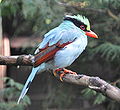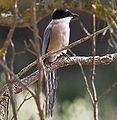| Magpie | |
|---|---|
| Scientific classification | |
| Kingdom: | |
| Phylum: | |
| Class: | |
| Order: | |
| Family: | |
| Genera | |
Magpies are birds of the Corvidae family. Like other members of their family, they are widely considered to be intelligent creatures. The Eurasian magpie, for instance, is thought to rank among the world's smartest creatures,[1][2] and is one of the few non-mammal species able to recognize itself in a mirror test.[3] In addition to other members of the genus Pica, corvids considered as magpies are in the genera Cissa, Urocissa, and Cyanopica.
Magpies of the genus Pica are generally found in temperate regions of Europe, Asia, and western North America, with populations also present in Tibet and high-elevation areas of India, i.e. Ladakh (Kargil and Leh) and Pakistan. Magpies of the genus Cyanopica are found in East Asia and the Iberian Peninsula. The birds called magpies in Australia are, however, not related to the magpies in the rest of the world (see Australian magpie).[4]
Name
There are references dating back to Old English in which the bird is called a "pie", derived from Latin pica; this term has fallen out of use.[5] There was a tendency in previous centuries to give birds common names, such as Robin Redbreast (which now is called the robin), Jenny Wren, etc. It is thought likely that the magpie was originally variously Maggie Pie and Mag Pie.[6] The term "pica" for some pregnant women's craving to eat non-foods is related to the tendency of the magpie (Pica pica) to feed on miscellaneous things.[7]
Systematics and species
According to some studies, magpies do not form the monophyletic group they are traditionally believed to be; tails have elongated (or shortened) independently in multiple lineages of corvid birds.[8] Among the traditional magpies, there appear to be two distinct lineages. One consists of Holarctic species with black and white colouration and is probably closely related to crows and Eurasian jays. The other contains several species from South to East Asia with vivid colouration, which is predominantly green or blue. The azure-winged magpie and the Iberian magpie, formerly thought to constitute a single species with a most peculiar distribution, have been shown to be two distinct species and classified as the genus Cyanopica.[9]
Other research has cast doubt on the taxonomy of the Pica magpies, since it appears that P. hudsonia and P. nuttalli may not be different species, whereas the Korean race of P. pica is genetically very distinct from the other Eurasian (as well as the North American) forms. Either the North American, Korean, and remaining Eurasian forms are accepted as three or four separate species, or there exists only a single species, Pica pica.[10]
Holarctic (black-and-white) magpies
- Genus Pica
- Eurasian magpie, Pica pica
- Black-billed magpie, Pica hudsonia (may be conspecific with P. pica)
- Yellow-billed magpie, Pica nuttalli (may be conspecific with P. (pica) hudsonia)
- Asir magpie, Pica asirensis (may be conspecific with P. pica)
- Maghreb magpie, Pica mauritanica (may be conspecific with P. pica)
- Korean magpie, Pica sericea (may be conspecific with P. pica)
- Black-rumped magpie. Pica bottenensis (may be conspecific with P. pica)
Oriental (blue and green) magpies
- Genus Urocissa
- Taiwan blue magpie, Urocissa caerulea
- Red-billed blue magpie, Urocissa erythrorhyncha
- Yellow-billed blue magpie, Urocissa flavirostris
- White-winged magpie, Urocissa whiteheadi
- Sri Lanka blue magpie, Urocissa ornata
- Genus Cissa
- Common green magpie, Cissa chinensis
- Indochinese green magpie, Cissa hypoleuca
- Javan green magpie, Cissa thalassina
- Bornean green magpie, Cissa jefferyi
Azure-winged magpies
- Genus Cyanopica
- Azure-winged magpie, Cyanopica cyanus
- Iberian magpie, Cyanopica cooki
Other "magpies"
- The black magpie, Platysmurus leucopterus, is a treepie; it is neither a magpie nor, as was long believed, a jay. Treepies are a distinct group of corvids externally similar to magpies.
- The Australian magpie, Cracticus tibicen, is conspicuously "pied", with black and white plumage reminiscent of a Eurasian magpie. It is a member of the family Artamidae and not a corvid.
Cultural references
East Asia
In East Asian culture, the magpie is a very popular bird. It is a symbol of good luck and good fortune.
The magpie is also a common subject in Chinese paintings. It is also often found in traditional Chinese poetry and couplets. In addition, in the folklore of China, all the magpies of the Qixi Festival every year will fly to the Tianhe River and set up on a bridge, where the separated Cowherd and Weaver Girl will meet, so that the bridge has come to symbolize a relationship between men and women.
Magpies have an important place in the birth myth of Ai Xinjue Luo Bukuri Yushun, the ancestor of the Qing Dynasty.
The Korean magpie, sometimes referred to as the Asian magpie or Chinese magpie, is a national bird and national symbol of Korea.
Pakistan
Magpies are also found widely in the northern areas of Pakistan, especially Baltistan. The common name in Baltistan is khaa-strap.
Europe
In European culture, the magpie is reputed to collect shiny objects, often, in fiction, things like wedding rings and other valuable or significant objects (sometimes causing consternation at their disappearance and the false accusation of humans in the story), the most well-known example probably being Rossini's opera "La Gazza Ladra" (The Thieving Magpie). Recent research[11] has shown that there is little truth in the legend, and that magpies, like many animals, are actually unsettled by shiny, blue, or otherwise unusual objects.
Gallery
References
- ^ Connor, Steve (19 August 2008). "Magpies reflect on a newly discovered intellectual prowess". The Independent.
- ^ "Eurasian Magpie: A True Bird Brain". Encyclopedia Britannica. Retrieved 5 February 2021.
- ^ Prior H, et al. (2008). De Waal F (ed.). "Mirror-Induced Behavior in the Magpie (Pica pica): Evidence of Self-Recognition". PLOS Biology. Public Library of Science. 6 (8): e202. doi:10.1371/journal.pbio.0060202. PMC 2517622. PMID 18715117.
- ^ Joseph, Leo (2017-12-12). "It's beloved, but Australia's magpie is an international bird of mystery | Leo Joseph". the Guardian. Retrieved 2020-10-19.
- ^ "pie". Oxford English Dictionary (Online ed.). Oxford University Press. (Subscription or participating institution membership required.)
- ^ "magpie". Oxford English Dictionary (Online ed.). Oxford University Press. (Subscription or participating institution membership required.)
- ^ "pica". Oxford English Dictionary (Online ed.). Oxford University Press. (Subscription or participating institution membership required.)
- ^ Ericson et al. (2005)
- ^ Kyukov et al, Synchronic east–west divergence in azure-winged magpies (Cyanopica cyanus) and magpies (Pica pica), Journal of Zoological Systematics and Evolutionary Research 42(4): 342-351 (2004)
- ^ Lee et al., 2003
- ^ https://www.bbc.co.uk/news/science-environment-28797519 [accessed 2019-12-2]
Bibliography
- Ericson, Per G. P.; Jansén, Anna-Lee; Johansson, Ulf S. & Ekman, Jan (2005): Inter-generic relationships of the crows, jays, magpies and allied groups (Aves: Corvidae) based on nucleotide sequence data. Journal of Avian Biology 36: 222–234.
- Lee, Sang-im; Parr, Cynthia S.; Hwang, Youna; Mindell, David P. & Choe, Jae C. (2003): Phylogeny of magpies (genus Pica) inferred from mtDNA data. Molecular Phylogenetics and Evolution 29: 250–257.
Further reading
- Song, S.; Zhang, R.; Alström, P.; Irestedt, M.; Cai, T.; Qu, Y.; Ericson, P.G.P.; Fjeldså, J.; Lei, F. (2017). "Complete taxon sampling of the avian genus Pica (magpies) reveals ancient relictual populations and synchronous Late-Pleistocene demographic expansion across the Northern Hemisphere". Journal of Avian Biology. 49 (2): jav-01612. doi:10.1111/jav.01612.
External links
- Magpie videos, photos and sounds on eBird




